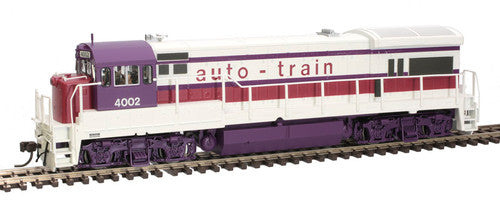Discover the Atlas 10003809 U36B Auto Train #4009 in stunning white, red, and purple gold finish. It's an HO scale model with DCC and sound features (note: picture might show a different road number). In the late 1960s, the horsepower race was intense. GE launched the 3,300hp U33B in 1967, and then upped the ante with the 3,600hp U36B in 1970. Both models share the same external look and are powered by the GE FDL - 16 cylinder four - stroke engine. The U36B was produced from May 1970 to December 1974. Atlas offers both early and late phase models. The early phase has flush - mounted radiator and air intake screens on the long hood and built - out areas on the top of the front and rear pilots. The late phase features corrugated screens and a flat pilot face. An optional electrical equipment box is included on the left side walkway behind the cab. Key features include a newly upgraded cab, separately - applied scale detail parts like windshield wipers and metal grab irons, a five - pole skewed armature motor with dual flywheels for smooth performance, directional lighting with golden - white LEDs, and blackened metal wheels. For DCC operation, it supports all programming modes, has flexible function key mapping, and follows NMRA standards. The LokSound Select Dual - Mode decoder allows use on both DC and DCC layouts. It also offers over 20 sound effects, 16 user - selectable horns, 2 user - selectable bells, and 2 user - selectable synchronized brake squeals, along with manual and automatic notching modes for a realistic experience.

Using this Atlas U36B Auto Train model is a breeze. First, if you're using a DCC layout, make sure your DCC system is set up according to the recommended standards. Connect the locomotive to the layout, and it should start running right away. You can control its speed, direction, and functions using the DCC controller. For DC operation, the LokSound Select Dual - Mode decoder enables the locomotive to work on a DC layout, but remember that the Atlas Quantum Engineer won't operate it on DC. When it comes to sound functionality, you can choose from a variety of sound effects and user - selectable options to enhance your experience. As for maintenance, keep the locomotive clean. You can use a soft brush to remove dust from the body, wheels, and other parts. Avoid using harsh chemicals as they might damage the paint or components. Store the locomotive in a dry place away from direct sunlight to prevent fading. And when using it on a DC - powered layout, don't couple it with a locomotive that doesn't have both DCC and sound. Have fun with your model train!









